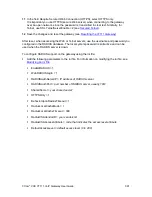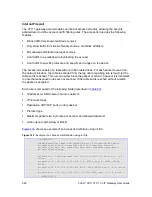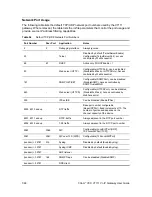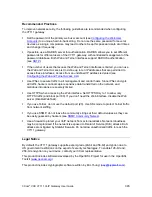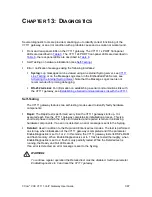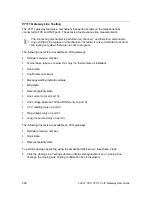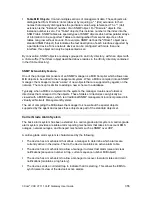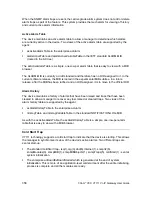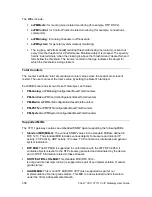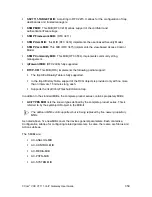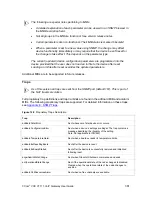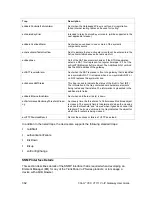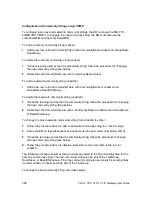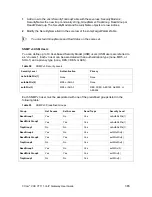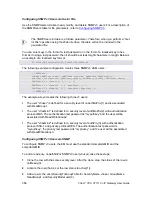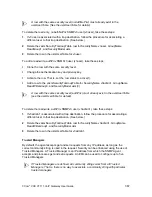
3Com
®
VCX V7111 VoIP Gateway User Guide
355
Table MIB Objects:
Contain multiple sections of management data. These objects are
distinguished from ‘Discrete’ items (above) by requiring a "." (dot) extension to their
names that uniquely distinguishes the particular value being referenced. The "." (dot)
extension is the "instance" number of an SNMP object. For "Discrete" objects, this
instance number is zero. For "Table" objects, this instance number is the index into the
SNMP table. SNMP tables are special types of SNMP objects which allow parallel arrays
of information to be supported. Tables are distinguished from scalar objects, so that
tables can grow without bounds. For example, SNMP defines the "ifDescr" object (as a
standard SNMP object) that indicates the text description of each interface supported by
a particular device. Since network devices can be configured with more than one
interface, this object can only be represented as an
By convention, SNMP objects are always grouped in an
Entry
directory, within an object with
a
Table
suffix. (The
ifDescr
object described above resides in the
ifEntry
directory contained
in the
ifTable
directory).
SNMP Extensibility Feature
One of the principal components of an SNMP manager is a MIB Compiler which allows new
MIB objects to be added to the management system. When a MIB is compiled into an SNMP
manager, the manager is made “aware” of new objects that are supported by agents on the
network. The concept is similar to adding a new schema to a database.
Typically, when a MIB is compiled into the system, the manager creates new folders or
directories that correspond to the objects. These folders or directories can typically be
viewed with a MIB Browser, which is a traditional SNMP management tool incorporated into
virtually all Network Management Systems.
The act of compiling the MIB allows the manager to know about the special objects
supported by the agent and access these objects as part of the standard object set.
Carrier Grade Alarm System
The basic alarm system has been extended to a carrier-grade alarm system. A carrier-grade
alarm system provides a reliable alarm reporting mechanism that takes into account EMS
outages, network outages, and transport mechanism such as SNMP over UDP.
A carrier-grade alarm system is characterized by the following:
The device has a mechanism that allows a manager to determine which alarms are
currently active in the device. That is, the device maintains an active alarm table.
The device has a mechanism to allow a manager to detect lost alarm raise and clear
notifications [sequence number in trap, current sequence number MIB object].
The device has a mechanism to allow a manager to recover lost alarm raise and clear
notifications [maintains a log history].
The device sends a cold start trap to indicate that it is starting. This allows the EMS to
synchronize its view of the device's active alarms.
Summary of Contents for VCX V7111
Page 30: ...30 3Com VCX V7111 VoIP Gateway User Guide Readers Notes ...
Page 44: ...44 3Com VCX V7111 VoIP Gateway User Guide Readers Notes ...
Page 53: ...3Com VCX V7111 VoIP Gateway User Guide 53 Readers Notes ...
Page 54: ...54 3Com VCX V7111 VoIP Gateway User Guide ...
Page 211: ...3Com VCX V7111 VoIP Gateway User Guide 211 Figure 76 IP Connectivity Screen ...
Page 235: ...3Com VCX V7111 VoIP Gateway User Guide 235 Readers Notes ...
Page 236: ...236 3Com VCX V7111 VoIP Gateway User Guide ...
Page 240: ...240 3Com VCX V7111 VoIP Gateway User Guide Readers Notes ...
Page 245: ...3Com VCX V7111 VoIP Gateway User Guide 245 Readers Notes ...
Page 246: ...246 3Com VCX V7111 VoIP Gateway User Guide ...
Page 281: ...3Com VCX V7111 VoIP Gateway User Guide 281 Readers Notes ...
Page 282: ...282 3Com VCX V7111 VoIP Gateway User Guide ...
Page 298: ...298 3Com VCX V7111 VoIP Gateway User Guide Readers Notes ...
Page 315: ...3Com VCX V7111 VoIP Gateway User Guide 315 Readers Notes ...
Page 316: ...316 3Com VCX V7111 VoIP Gateway User Guide ...
Page 319: ...3Com VCX V7111 VoIP Gateway User Guide 319 Readers Notes ...
Page 320: ...320 3Com VCX V7111 VoIP Gateway User Guide ...
Page 346: ...346 3Com VCX V7111 VoIP Gateway User Guide Readers Notes ...
Page 351: ...3Com VCX V7111 VoIP Gateway User Guide 351 Readers Notes ...
Page 352: ...352 3Com VCX V7111 VoIP Gateway User Guide ...
Page 376: ...376 3Com VCX V7111 VoIP Gateway User Guide Readers Notes ...
Page 386: ...386 3Com VCX V7111 VoIP Gateway User Guide Readers Notes ...
Page 394: ...394 3Com VCX V7111 VoIP Gateway User Guide Readers Notes ...
Page 396: ...396 3Com VCX V7111 VoIP Gateway User Guide Readers Notes ...
Page 405: ...3Com VCX V7111 VoIP Gateway User Guide 405 Reader s Notes ...
Page 406: ...406 3Com VCX V7111 VoIP Gateway User Guide ...
Page 410: ...410 3Com VCX V7111 VoIP Gateway User Guide ...
Page 426: ...426 3Com VCX V7111 VoIP Gateway User Guide Readers Notes ...
Page 432: ...432 3Com VCX V7111 VoIP Gateway User Guide Figure 153 Prerecorded Tones Screen ...
Page 452: ...452 3Com VCX V7111 VoIP Gateway User Guide Readers Notes ...
Page 456: ...456 3Com VCX V7111 VoIP Gateway User Guide Readers Notes ...

